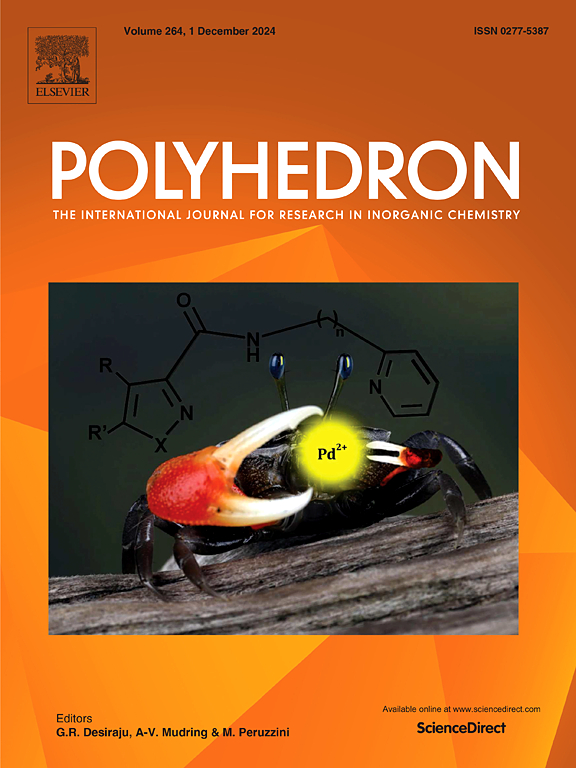含富碳炔基功能化亚吡啶配体的三核铜(I)-卤化物/伪卤化物配合物:合成、表征、发光和NLO性质
IF 2.4
3区 化学
Q2 CHEMISTRY, INORGANIC & NUCLEAR
引用次数: 0
摘要
在三苯基膦存在下,铜盐与亚氨基吡啶配体反应合成了一系列新的三核铜(I)配合物,特别是[Cu3(L1)(PPh3)3X3] (1a-d)和[Cu3(L2)(PPh3)3X3] (2a-d)。其中X代表Cl、I、N3或NCS。这项工作概述了我们的合成方法和成功,以及所得化合物的详细光谱和电子表征。利用热分析和电化学分析对卤化物和伪卤化物进行了比较。热重谱清楚地表明,卤化物配合物的热稳定性低于假卤化物配合物。该配合物表现出热稳定性,并表现出Cu(I)/Cu(II)偶对典型的准可逆氧化还原行为。在室温下,化合物在红色区域发光,并根据卤化物和假卤化物的不同具有不同的给电子和猝灭效应。此外,利用Kurtz-powder方法对配合物的二次谐波产生(SHG)效率进行了评价,表明了它们作为非线性光学材料的潜力。本文章由计算机程序翻译,如有差异,请以英文原文为准。

Trinuclear copper(I)-halide/pseudohalide complexes containing carbon-rich alkynyl functionalized iminopyridine ligand: Synthesis, characterization, luminescence and NLO properties
A new series of trinuclear copper(I) complexes, specifically [Cu3(L1)(PPh3)3X3] (1a-d) and [Cu3(L2)(PPh3)3X3] (2a-d), have been synthesized by reacting copper salts with iminopyridine ligands in the presence of triphenylphosphine, where X represents Cl, I, N3, or NCS. This work outlines our synthetic methods and successes, along with detailed spectroscopic and electronic characterizations of the resulting compounds. A comparison between halides and pseudohalides was conducted using thermal and electrochemical analyses. The thermogravimetric profiles clearly demonstrate that halide complexes are less thermally stable than pseudohalide complexes. The complexes demonstrated thermal stability and exhibited quasireversible redox behaviour typical of the Cu(I)/Cu(II) couple. At room temperature, the compounds showed luminescence in the red region, with varying electron-donating and quenching effects depending on the halides and pseudohalides. Furthermore, the second harmonic generation (SHG) efficiency of the complexes was evaluated using the Kurtz-powder method, indicating their promising potential as nonlinear optical materials.
求助全文
通过发布文献求助,成功后即可免费获取论文全文。
去求助
来源期刊

Polyhedron
化学-晶体学
CiteScore
4.90
自引率
7.70%
发文量
515
审稿时长
2 months
期刊介绍:
Polyhedron publishes original, fundamental, experimental and theoretical work of the highest quality in all the major areas of inorganic chemistry. This includes synthetic chemistry, coordination chemistry, organometallic chemistry, bioinorganic chemistry, and solid-state and materials chemistry.
Papers should be significant pieces of work, and all new compounds must be appropriately characterized. The inclusion of single-crystal X-ray structural data is strongly encouraged, but papers reporting only the X-ray structure determination of a single compound will usually not be considered. Papers on solid-state or materials chemistry will be expected to have a significant molecular chemistry component (such as the synthesis and characterization of the molecular precursors and/or a systematic study of the use of different precursors or reaction conditions) or demonstrate a cutting-edge application (for example inorganic materials for energy applications). Papers dealing only with stability constants are not considered.
 求助内容:
求助内容: 应助结果提醒方式:
应助结果提醒方式:


